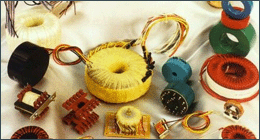Toroidal transformers are frequently used because of their compact size and performance benefits. Toroids perform in a wide range of different applications. These transformers are commonly used in telecommunications, medical devices, ballasts, EMI filters, and musical instruments. Toroids are made from different core materials to meet the specific needs of end applications. Different materials allow for heightened characteristics. For instance, when using toroids in AC currents, the core must be made from non-solid and non-electrically conductive materials. If wrong materials are used, it is possible for overheating of the core (causing loses) and excessive eddy current flow. Cores are either made from thin metal laminations or powdered magnetic materials. Below, we will talk about the most commonly used materials for making toroids and transformer winding.

Powdered Iron: this is a soft ferrite ceramic material. It is ideally used in environments that have significant DC in the winding. The material offers low permeability. They are designed for high-frequency operations. Typically, the material is used without air-gaps, which means they will not saturate easily. Powdered iron is most commonly used as a filter choke inside switching power supplies, as well as EMI filters.
Ferrite: A soft ferrite is a mainstay for switching power supplies because they function as low-level, high-speed transformers. Ferrites come with outstanding permeability that allows small cores to have substantial power capabilities.
MuMetal: This material has extraordinarily high permeability. It is most frequently used for magnetic shielding in cathode ray tubes that are in higher-quality oscilloscopes. They are also used for screening cans in microphone transformers and for laminations in low-level transformers. Maximum flux density is considerably low when compared to other metallic materials.
We work all toroid core materials. Regardless of your needs, including encapsulated toroidal transformers, we want to offer our coil winding services to you.
Related Reading about Toroid Transformer
- Essential Things to Know About Toroids and Transformer Winding
Understanding the ins-and-outs of toroidal transformers is confusing because of different winding techniques, core materials, and toroid sizes. To try and simplify this complex field, we want to address some of the most commonly asked questions we hear.
- Frequently Asked Questions about Toroidal Transformers and Coil Winding
- The Main Reasons Engineers Use Toroidal Transformers
- What are the Differences Between Ferrite and Powdered Iron Cores?

